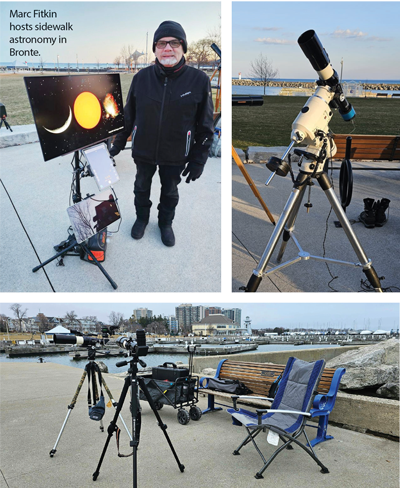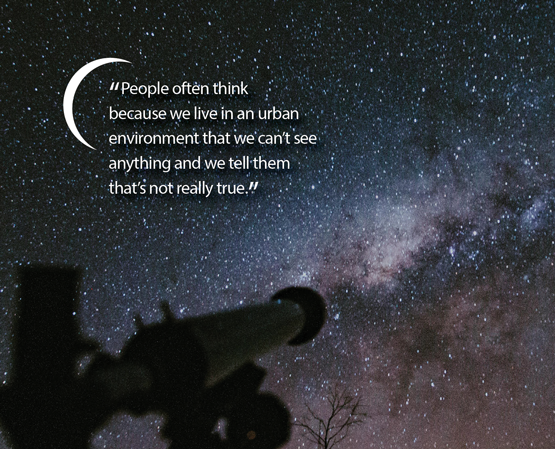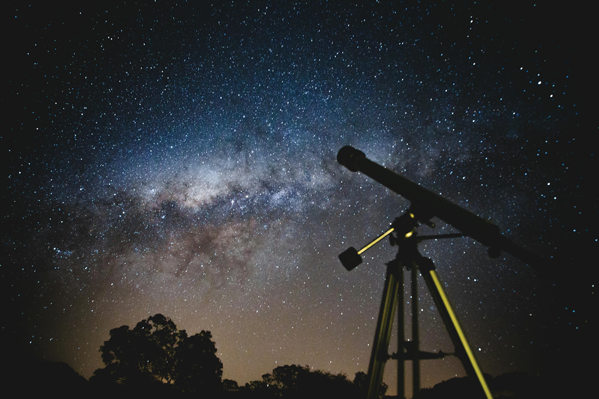Oakville resident Marc Fitkin grew up watching 2001 Space Odyssey and being fascinated by the night sky. By the time he got his first department store telescope at the age of 12, he was hooked on astronomy.
In 2018, Fitkin and his wife, Karen, moved to Oakville and one evening, Fitkin decided to set up one of his telescopes at Bronte Heritage Park. He invited passersby to peek through and get a glimpse at the night sky. “The public seemed to enjoy it,” says Fitkin. “The crowds were getting bigger. Then COVID hit and that was the end of it.”
Throughout the COVID lockdown, Fitkin couldn’t allow other people to look through his telescope, but he wanted to share what he could see in the night sky and began posting photos from his telescope on a Facebook group called Bronte Neighbours Helping Bronte Neighbours.
Interest in his photos grew, prompting Fitkin to form his own Facebook Group called The Bronte Astronomer. In August 2022, he returned to Bronte Heritage Park with his telescopes, hosting astronomy events that, he says, are an adaptation of the popular practice of sidewalk astronomy.

Sidewalk astronomy, also called street corner astronomy, operates on a straightforward principle: to educate the public about the universe by peering through telescopes. This grassroots approach to stargazing has taken different forms over the years. Astronomer John Dobson, inventor of the Dobsonian telescope, is said to have pioneered the practice in the 1960s when he assembled telescopes on urban street corners, inviting the public to view the night sky. “His famous words are ‘just come look at the moon’,” says Fitkin.
This is exactly what you hear Fitkin and other volunteers saying at Bronte Heritage Park. “We’ll say to people, hey, do you want to see the moon? Do you want to see the rings of Saturn? Do you want to see Jupiter?” he says. Passersby are often so amazed at what they’re seeing, some even think they’re being tricked. “They’ll say oh, you have a picture in there and we’re like no, no, that’s real,” laughs Fitkin.
While Dobson’s version of sidewalk astronomy saw astronomers spontaneously setting up telescopes on various urban street corners, continually moving around cities, Fitkin and his volunteers have reimagined the concept, creating a regular gathering at Oakville’s
Bronte Heritage Park. Through The Bronte Astronomer Facebook page, Fitkin notifies its 2,000-plus followers about upcoming events. Interest in these stargazing events has grown over the past two years. “We’re getting close to 200, 300 people some nights,” says Fitkin.

Fitkin’s vision is inclusive and accessible. With a goal of hosting at least one event per month, he extends an open invitation to anyone curious about astronomy. “It’s astronomy for everyone — kids, adults, anyone with an interest,” Fitkin emphasizes. Volunteers, armed with their telescopic expertise, offer guidance and insights, fostering a welcoming environment for novices and enthusiasts alike.
Fitkin and fellow volunteers set up their own telescopes, sometimes amassing over a dozen telescopes. Frequently amateur astronomers will bring their own telescopes to the events to ask volunteers for pointers on how to use them. Fitkin often brings an electronically assisted telescope that projects celestial objects onto a screen for easy viewing. “It makes it easy for public viewing so you don’t have a bunch of people trying to look through the telescope,” he says.
Engagement is key during these events. Passersby are encouraged to ask questions about what they’re seeing through the lens — even asking questions as simple as what exactly is a star — sparking discussions about the mysteries of the night sky. Fitkin notes that volunteers are always eager to demystify astronomy, addressing queries about stars, planets and beyond.
“The goal is to educate others and advance the public’s understanding of astronomy,” Fitkin affirms, while also dispelling the misconception that urban environments hinder stargazing. “People often think because we live in an urban environment that we can’t see anything and we tell them that’s not really true. Here’s what you can see.”






